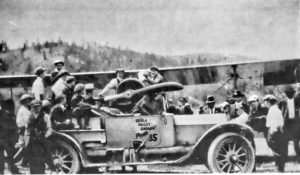Original article by the late Pat Lean, then Director, Nicola Valley Archives Association.
As published in the Merritt Herald – Wednesday, April 27, 1977 Page 3B.

Aldermen J.P. Boyd’s Nicola Valley Garage big “Service” car was right on the job when Captains Dixon and Hoy arrived with the first flight into the Nicola Valley on June 29, 1919. Note the “right hand” drive. British Columbia didn’t move over to the other side of the road until 1922. (Photo from private collection of Eleanor MacVicar, Kamloops, B.C., daughter of J. P. Boyd.)
The Spring of 1919 could truly be referred to as the “spring of hope” for the Nicola Valley as well as the rest of Canada.
The “Great War” was over. As the spring rains brought forth the green grass in the Valley and on the hills there was an air of renewed hope for a long period of peace and tranquillity.
Other things added to the feelings of optimism that spring in Merritt and its environs.
The heroes of the war were returning home after having vanquished the hun. Each week saw another one or two of the conquerors return. There was great rejoicing.
Those 45 men who did not make it back were properly remembered by all and considerable efforts were being put forth towards erecting a proper memorial in their honour but this did not in any way serve to dampen the spirits of all segments of the society.
Major C. S. Goldman, that silvery-tongued British Journalist/Politician with considerable means also arrived to make the Nicola Valley his “home”. His talks to the people and rumoured plans to purchase large tracts of land tended to strengthen the faith of the people in their Valley.
It was into this optimistic atmosphere that Captain E. C. Hoy, D.F.C. arrived the evening of June 19, 1919. The Captain’s job was to search out a suitable landing field for a proposed inaugural flight to begin in Vancouver and to end in Calgary.
This “pathfinder trip” was to be made by Captain Hoy and Captain George Dixon, both of Vancouver who had been in the Canadian Army but moved over to the newly-formed Royal Air Force during the War.
Subsequent to the war (to boost Canadian aviation), the Aerial League of Canada was formed. This body along with the Vancouver Air Transportation Company was sponsoring the trip with the hope that it would become a commercial enterprise in 1920.
By the evening of June 20th, all steps necessary for the proper reception of the flight expected June 28th had been taken. A committee consisting of S. L. Smith, J. P. Boyd. J. W. Ellis, Dr. J. J. Gillis, H. C. Meeker, N. J. H. Brown, D. D. Lapsley. G. B. Armstrong. E. R. Williams. M. A. Durland and Joseph Graham was struck. H. S. Cleasby. Mayor M. R. Grimmett and W. H. Innes were added later. Captain Hoy contacted F. R. Corp and Charles Houston to act as mechanics for the plane if necessary. Mr. Corp and Hugh McKibbon were also charged with the responsibility of marking out the landing strip on Blair field between Merritt and Middlesboro.
Plans were made to have a “tag day” prior to the day of arrival in order to advertise the “great event” and to raise money for the Aerial League. These “tags” would be sold for 25c to adults and 15c to children.
The Great War Veterans Association made plans for a large dance on the evening of the arrival as it was expected that the greatest crowd ever seen in the Nicola Valley would be on hand to witness this historical event.
But, alas, the weather was unkind and required a 24 hour delay in the “hop off” from Chilliwack, arriving in Merritt at 12:25 p.m., June 29, 1919, to the blare of the city siren, the coal companies’ whistles and the horns of automobiles. Even though they were a day late, a good crowd too was hand to greet the pioneer airmen.
After welcoming formalities, the airmen explained the workings of their Canadian Curtis N.J. 4 “aeroplane”, then gave a further demonstration flight around the valley.
After dinner they were taken by automobile to Douglas Lake where they were entertained by Mr. and Mrs. F. B. Ward. On Monday they flew to Armstrong, dropping a package for Mr. and Mrs. Ward as they passed Douglas Lake.
While in Merritt the local business men were advised that plans had been altered and that this flight would proceed only to Armstrong then return to Vancouver via Merritt. On their return they would take passengers for short flights over the city.
A total of $124.20 was raised for the Aerial League of Canada in the sale of tags. Alderman J. P. Boyd’s big “service” car was right on the job with gasoline.
On the return trip from Armstrong July 12, Mr. Boyd, accompanied by Mr. Joseph Graham, Manager of Flemming Coal Company, travelled to Douglas Lake to service the plane. Mr. Graham, taking the opportunity to become the first man of the Valley to take a flight, returned with Captain Dixon to Merritt. Captain Hoy accompanied Mr. Boyd.
During their stay in the valley on this trip, G. B. Armstrong, N. J. H. Brown, Dr. J. J. Gilles, F. B. Ward and his daughter Betty, aged ten, Gordon Ellis, J. W. Ellis. S. L. Smith, J. P. Boyd, L. E. Morrissey. W. C. Cranna, Miss Fay Gay, M. A. Durland. 0. Wilkie, H. S. Cleasby. H. B. McKelvie and Ralph Carrington took flights. It was believed at the time that Miss Ward was the youngest person ever to have flown in Canada. Mr. McKelvie was a travelling salesman and he made the trip from Merritt to Douglas Lake for the purpose of taking an order. It was believed at the time that this too was the “first” use of an aeroplane for this purpose in Canada.
The heroes of the first manned flight in the Nicola Valley flew out for Chilliwack and Vancouver July 14. 1919.
Future flights into the valley would now get little more that yawns, as happened July 27th when Lieutenant Hall arrived. He took Mayor Grimmett, H. C. Meeker. 0. Wilkie, Harry Anderson, Harry Collett, and Noah Boyden for excursion flights but otherwise there was little fanfare.
On July 30th. J. P. Boyd received a telegram from the Aerial League of Canada that there would be another plane arriving for servicing on August 3rd.
The Air Age had truly arrived in the Nicola Valley. (All information in this article has been drawn from the back issues of the Merritt Herald.)
